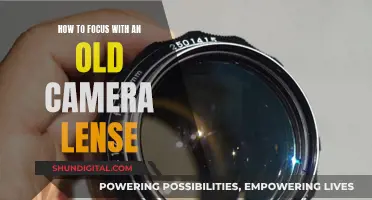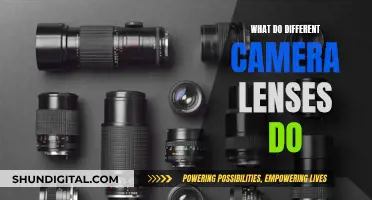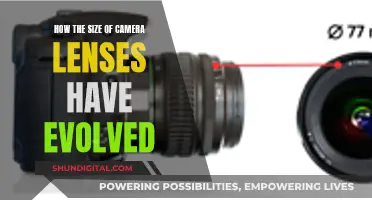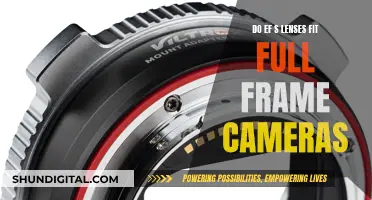
Camera lenses come in a variety of sizes and types, and choosing the right one can be a complex trade-off between cost, size, weight, lens speed, and image quality. The two main types of camera lenses are zoom lenses and prime lenses. Zoom lenses offer a versatile range of focal lengths, allowing photographers to zoom in and out, while prime lenses have a fixed focal length, delivering higher-quality images for specific types of photography. The focal length of a lens determines its angle of view and magnification, with wide-angle lenses having shorter focal lengths and telephoto lenses having longer ones. The diameter of a lens is influenced by the size of the entrance pupil and the field of view, with telephoto lenses having narrower fields of view and wide-angle lenses capturing a wider angle.
| Characteristics | Values |
|---|---|
| Purpose | To direct light and determine how much light passes through |
| Focal point | The point in front of the camera sensor or film where light is directed to |
| Focal length | Distance between the focal point and the sensor; defines angle of view of a lens |
| Prime lens | Fixed focal length; fewer moving parts; wider maximum aperture; less versatile; cheaper |
| Zoom lens | Variable focal length; more versatile; usually more expensive; heavier; smaller maximum apertures |
| Standard lens | Focal length between 35mm and 85mm; field of view similar to the human eye |
| Wide-angle lens | Focal length between 14mm and 35mm; wide field of vision; panoramic |
| Ultra-wide-angle or fisheye lens | Focal length less than 14mm; enormous field of view; warping effect |
| Telephoto lens | Incredible magnification; narrow angle of view; small maximum aperture |
| Super-telephoto lens | Focal length above 300mm; big, heavy, and expensive |
| Macro lens | Captures objects at very close range; not categorized by focal length alone |
| Tilt-shift lens | Distorts and changes the perspective of a shot; controls depth of field and perspective |

Zoom lenses vs. prime lenses
There are two main types of camera lenses: zoom lenses and prime lenses. The main difference between them is that zoom lenses have a variable focal length, while prime lenses have a fixed focal length.
Zoom Lenses
Zoom lenses are incredibly versatile. With a zoom lens, you can change the focal length within a pre-defined range, allowing you to zoom in or out on your subject without physically moving. The most popular zoom lens is the 70-200mm lens, often used by wedding photographers. Zoom lenses are also great when you need to adapt quickly to moving subjects or when you're not sure what conditions you'll be shooting in. They are heavier than prime lenses, but their wider focal range makes them far more versatile.
Prime Lenses
Prime lenses have a fixed focal length, which means you can't zoom in or out. Instead, the only way to change the magnification of your subject is by physically moving closer or further away. Prime lenses are generally smaller, lighter, and offer better low-light performance than zoom lenses. They also tend to be sharper and have wider apertures, allowing for better bokeh (background blur). Prime lenses are ideal if you're looking for a beautiful portrait lens or a lighter lens to carry around.
So, which type of lens is better? It depends on your needs and preferences. If you want versatility and the ability to quickly adapt to different situations, a zoom lens might be the best choice. On the other hand, if you're looking for a lightweight lens with excellent low-light performance and the ability to create beautiful bokeh, a prime lens could be the way to go. Ultimately, the best lens for you will depend on the type of photography you do and your personal preferences.
Understanding Camera Lenses: Mastering Focal Lengths
You may want to see also

Wide-angle lenses
The most popular wide-angle zoom range is 16-35mm, while most kit or standard zoom lenses are 24mm or 28mm. The widest lenses on the market are 10mm (rectilinear lenses) and 8mm (fish-eye lenses).
Another common use for wide-angle lenses is in enclosed spaces, where the photographer cannot move far enough away from their subject to get everything in the photo using a normal lens.
When using a wide-angle lens, it is important to have a clear subject in the image and not just try to fit as much "stuff" into the image as possible. This will give your image layers of depth and make people want to look at it more closely.
Shade Covers for Cameras: What Are They?
You may want to see also

Telephoto lenses
While telephoto lenses offer a narrow field of view, they can be useful for landscape photography in certain situations. For example, they can be used to capture distant landscapes and compress perspective, or to capture details and scenes in the distance. However, they may not be the best choice for landscape photography due to their limited perspective and atmospheric challenges beyond a certain focal length.
Super telephoto lenses, which have a focal length of 300mm or more, are typically used by professional wildlife photographers and sports photographers. These lenses provide an extremely narrow field of view and can capture fine details of distant subjects. They are often large, heavy, and expensive, making them less accessible to amateur photographers.
Humidity and Camera Gear: Is 43% Too Low?
You may want to see also

Focal length
The focal length of a lens determines its angle of view and how much the subject will be magnified for a given photographic position. Wide-angle lenses have short focal lengths, while telephoto lenses have longer corresponding focal lengths. The longer the focal length, the narrower the angle of view and the more zoomed-in it appears.
Wide-angle lenses have a wider field of view, allowing you to capture more of the scene in front of you. They are commonly used for landscape, architecture, and interior photography. On the other hand, telephoto lenses allow you to "get closer" to your subject by enlarging it within the frame. They are useful for sports, wildlife, and distant nature scenes.
It's important to note that the camera's sensor size also affects the visual impact of the lens. Different sensor sizes, such as Four Thirds, APS-C, and full-frame, will result in variations in the angle of view covered by the lens.
Protecting Your Camera Lenses: Tips for Longevity
You may want to see also

Aperture
The size of the aperture (the f-stop number) determines the amount of light that enters the camera and hits the image sensor. The larger the aperture, the more light that enters the camera. This is important because it allows you to control exposure. The aperture also controls the depth of field in your photograph, which is the distance between the nearest and furthest objects in a scene that appear sharp. The larger the aperture, the shallower the depth of field, and vice versa.
The size of the aperture also determines the shutter speed and ISO settings needed to achieve the correct exposure. A large aperture (small f-number) will require a faster shutter speed and a higher ISO setting to avoid overexposure. Conversely, a small aperture (large f-number) will require a slower shutter speed and a lower ISO setting.
Different lenses have different ranges of aperture settings, with maximum and minimum apertures. The maximum aperture tends to be the most important as it tells you how much light the lens can gather and how dark an environment you can take photos in. Lenses with large maximum apertures are known as "fast" lenses and are usually more expensive. The minimum aperture is less important as almost all modern lenses can provide at least f/16.
Detecting Radioactivity in Camera Lenses: A Guide
You may want to see also







